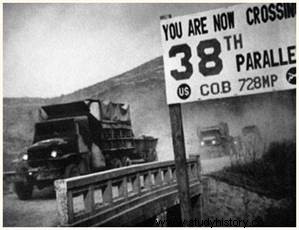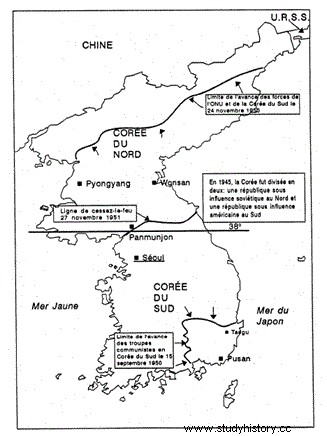 The Korean War was a conflict between the two Koreas from 1950 to 1953. It was caused by the invasion of North Korean troops in South Korea, at dawn on June 25, 1950. In the context of the Cold War, this invasion led to the intervention of an international coalition led by the United States in support of the South Korean army, then that of China , an ally of North Korea. In less than a year, the peninsula passed under the almost total control of each of the two camps, without either of them achieving victory. The fighting continued for two years around the 38th parallel and end with the signing of the armistice of July 27, 1953 . The ceasefire line becomes the new border of the two states.
The Korean War was a conflict between the two Koreas from 1950 to 1953. It was caused by the invasion of North Korean troops in South Korea, at dawn on June 25, 1950. In the context of the Cold War, this invasion led to the intervention of an international coalition led by the United States in support of the South Korean army, then that of China , an ally of North Korea. In less than a year, the peninsula passed under the almost total control of each of the two camps, without either of them achieving victory. The fighting continued for two years around the 38th parallel and end with the signing of the armistice of July 27, 1953 . The ceasefire line becomes the new border of the two states.
At the origins of the Korean War
At the end of the Second World War, Korea, a Japanese possession since 1910, was divided into two occupation zones. North of the 38th parallel a Soviet zone, to the south a zone supported by the United States. It had been planned to reunify the country after free elections, but differences of opinion between Moscow and Washington led to a definitive partition in 1948. In Pyongyang, the USSR ensured that Kim Il Sung, a former communist anti-Japanese resistance fighter, took power. In the south the Americans found their man in the old nationalist leader Syngman Rhee. The two Koreas had in common that they claimed to represent the whole country while being under the thumb of authoritarian regimes.
 For two years Pyongyang and Seoul would maintain tense relations, fueled secretly by the Cold War, which experienced its first fires. The Soviets and Chinese were initially unreceptive to the insistent demands of Kim Il Sung, who wanted to reunite the country by force. Yet at the beginning of 1950 it appeared in Moscow that in the event of an armed conflict, the North could quickly win. The army of the Democratic People's Republic of Korea can field almost 200,000 soldiers well equipped with proven equipment (T-34 tanks, powerful artillery, modern aviation).
For two years Pyongyang and Seoul would maintain tense relations, fueled secretly by the Cold War, which experienced its first fires. The Soviets and Chinese were initially unreceptive to the insistent demands of Kim Il Sung, who wanted to reunite the country by force. Yet at the beginning of 1950 it appeared in Moscow that in the event of an armed conflict, the North could quickly win. The army of the Democratic People's Republic of Korea can field almost 200,000 soldiers well equipped with proven equipment (T-34 tanks, powerful artillery, modern aviation).
Faced with this device, South Korea only fields 95,000 men with only light equipment. The Americans who are still dealing with the drop in military personnel resulting from the demobilization could send only a few troops to the aid of Seoul. In view of this observation Stalin agrees to let Kim Il Sung try his luck with armed force.
The North Korean invasion and the American reaction
June 25, 1950. The Korean War will begin, last three years and horribly ravage the land of morning calm. At four o'clock in the morning the border which separates the Democratic People's Republic of Korea (or North Korea) from the Republic of Korea (South Korea) is set ablaze. Thousands of artillery tubes unleash a hellish fire on the positions that the North Korean troops will storm. The invasion of South Korea takes Washington by surprise and at first the North Korean advance seems irresistible. Seoul was taken after only three days of fighting and at the beginning of the autumn the southern troops only held a small redoubt in the south east of the country in the Pusan region. Nevertheless the United States does not remain inactive.

 After condemning the invasion by the United Nations Security Council on the 25th (following the absence of the representative of the USSR who then practiced the "empty chair policy"), Washington obtained a UN mandate to form a multinational force to repel the North Koreans.
After condemning the invasion by the United Nations Security Council on the 25th (following the absence of the representative of the USSR who then practiced the "empty chair policy"), Washington obtained a UN mandate to form a multinational force to repel the North Koreans.
The coalition forces are based on both the 8th US Army and troops from 16 states (mainly Commonwealth nations, but also a French battalion). Everything is under the orders of General Douglas MacArthur, until then at the head of the occupation of Japan. In mid-September 1950, while the North Koreans tried in vain to destroy the Pusan redoubt, MacArthur's forces landed in their rear at Inchon.
Operation Chromite was a resounding success, the UN troops benefiting from air superiority and valuable support from the US Navy. Threatened with encirclement, the North Koreans retreat in disorder and have to abandon Seoul (September 26, 1950). On October 26, UN troops reached the Yalu River, in northern Korea on the Chinese border.
The Chinese Intervention and the end of the Korean War
Kim Il Sung's regime owes its survival only to the intervention of the People's Republic of China. Mao, who got rid of the nationalists the previous year, has a free hand to play a leading role in Asia. Thus at the beginning of November, nearly fifty Chinese divisions crossed the Yalu. If officially they are volunteers, in fact the Fourth Army comes out of Beijing. In the air it is covered by a supposedly North Korean aviation, in reality at the controls of Soviets, and which aligns the famous Mig 15, aircraft then outclassing all their rivals.
Faced with such a deployment of force MacArthur's troops can only retreat, North Korea is quickly liberated by Chinese troops. The situation is so serious for the American general that he asks President Truman to carry out nuclear strikes on Manchuria. These demands and the radicalism of his anti-Chinese commitment earned him his replacement by General Ridgway in April 1951. After having come close to disaster in the winter of 1950-1951, the UN and South Korean forces pulled themselves together and the war of movement gradually giving way to a costly war of attrition. In the summer of 1953 the front line stabilized not far from the 38th parallel.
A war for nothing?
 The negotiations, led by American and Soviet diplomats who wanted to keep their confrontation under control, ended up leading to a ceasefire on July 27, 1953. The agreement put an end to the fighting on the Korean peninsula, even if a definitive peace treaty between the two Koreas has still not been signed. The armistice of Pan Mun Jon confirms the division of the two Koreas with few territorial changes from the situation in 1950.
The negotiations, led by American and Soviet diplomats who wanted to keep their confrontation under control, ended up leading to a ceasefire on July 27, 1953. The agreement put an end to the fighting on the Korean peninsula, even if a definitive peace treaty between the two Koreas has still not been signed. The armistice of Pan Mun Jon confirms the division of the two Koreas with few territorial changes from the situation in 1950.
The Korean War was extremely deadly:18,500 United Nations troops (including Americans), 70,000 South Koreans, about 2 million North Koreans and Chinese, plus of three million civilians killed by bombardments, epidemics... From the start, this conflict had taken on international significance. In its first weeks, it raised fears of the outbreak of a Third World War, but the Soviet Union, which had certainly been informed of the preparations for the North Korean attack and was no doubt contemplating at that time only a war localized, refrained from intervening as soon as the resolve of the United States asserted itself.
For the first time, the two Greats are clearly cashing in on their desire to avoid an irremediable face-to-face. The American government, in deciding on the dismissal of MacArthur (April 1951), also refused the risk of a generalized conflict with China. Thus, contrary to the fears of Washington's European allies, American policy, despite the Korean War, remained faithful to the priority it had given to Europe as early as 1947.
Civil War, the Korean War was also one of the paroxysmal moments of the Cold War. It was one of the few high-intensity conflicts where the United States and the Soviet Union were able to confront each other almost directly. A real disaster for the land of the morning calm, its consequences are still being felt today both in Pyongyang and Seoul as well as on the demarcation line.
To go further
- The Korean War, by Ivan Cadeau. Tempus, 2016.
- The Korean War 1950-1953. Cold War in East Asia by Patrick Souty. Pul, 2002.
- Wars of the 20th Century, Vol.2:The Korean War. Documentary, DVD, 2005.
